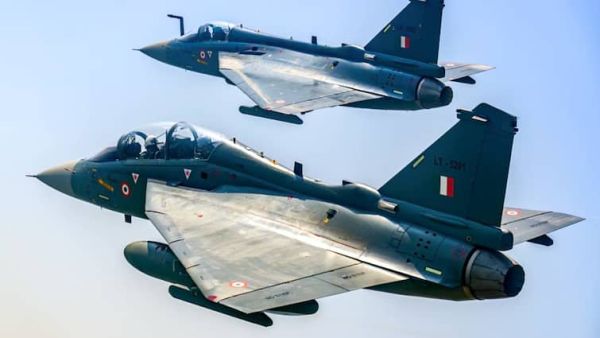
India's skies are about to get a major upgrade. As the Indian Air Force prepares to induct the Tejas Mk‑1A by 2026, a question looms large over airbases, defence circles, and drawing-room debates alike: How does India's homemade fighter jet compare to global warbirds like the French Rafale, American F‑16, and China-Pakistan's JF‑17 Thunder?
Let's break down this high-altitude showdown — one fighter at a time.
Tejas Mk‑1A: India's Homegrown Hawk Takes Flight
The Tejas Mk‑1A isn't just another fighter jet — it's a symbol of India's self-reliance in defence manufacturing. Built by Hindustan Aeronautics Limited (HAL), this upgraded variant of the Tejas Light Combat Aircraft (LCA) has been fine-tuned to address operational feedback from the Indian Air Force (IAF).
Armed with Israeli-origin AESA radar, electronic warfare suites, mid-air refuelling capability, and reduced maintenance time, the Mk‑1A offers a serious boost in survivability and flexibility. The IAF has ordered 83 units, with deliveries expected to begin before March 2026.
But the question remains — how does it stack up against the competition?
Rafale: The French Falcon Already In Indian Skies
India's existing frontline fighter, the Dassault Rafale, is a beast in its own right. Known for its multi-role versatility, twin-engine thrust, and cutting-edge sensors, the Rafale is already combat-tested in real-world operations.
It flies higher (ceiling \~50,000 ft), faster (Mach 1.8), and longer (3,700 km range with external fuel tanks) than the Tejas Mk‑1A. Its radar signature is also significantly lower due to stealthier design features.
But so is the price tag.
While a single Tejas Mk‑1A costs around ₹306 crore, the Rafale is estimated at ₹1,000 crore+ per unit when accounting for India-specific customisations. In terms of cost-to-capability ratio, Tejas is clearly playing the long game.
F‑16: The Global Veteran
The Lockheed Martin F‑16 Fighting Falcon has more than 4,600 units flying across 25 countries, making it one of the most battle-proven jets in history. While newer variants like the F‑16 Block 70/72 have modern avionics and AESA radar, they're also built for air superiority with global logistics support that India's Tejas is still developing.
That said, the F‑16 is a foreign platform, and strategic autonomy has become a top concern for New Delhi. Also, Pakistan flies its own fleet of F‑16s, raising questions about whether India would want to mirror a similar platform if it ever revisits imports in that category.
JF‑17: Pakistan And China's Affordable Workhorse
Developed jointly by Pakistan and China, the JF‑17 Thunder is often compared with the Tejas, mostly due to their single-engine configurations and similar roles in regional air defence.
However, the Tejas Mk‑1A boasts a more powerful GE F404 engine, superior composite materials, and better avionics, especially with the addition of Israeli AESA radar. The GEF404's thrust-to-weight ratio and fuel efficiency are far superior to the single Russian RD-93 turbofan engine used by the JF-17. This makes Tejas more agile and manoeuvrable than the JF-17.
The JF‑17, despite being cost-effective and easily upgradable, has suffered from reliability issues and a more limited operational history.
Moreover, the Tejas has a lower radar cross-section, meaning it can stay out of the radar's detection area longer.
In short, Tejas Mk‑1A far better equipped for long-term combat viability, particularly in high-threat scenarios.
What The Comparison Tells Us
So, where does the Tejas Mk‑1A truly stand?
Against Rafale, it's not a rival but a complementary asset ideal for replacing the ageing MiG-21s and boosting fleet numbers at lower cost.
Compared to the F‑16, it lacks global combat history but offers greater strategic control to India. It scores higher on both technology and credibility when compared to the JF‑17, making it a potential export contender as well.
But more than numbers, this comparison tells a larger story.
A Jet That Represents More Than Firepower
Tejas Mk‑1A is not just an aircraft. It's a statement of India's growing defence manufacturing capability, a boost to the Make-in-India push, and a response to decades of import dependence.
In the coming years, it will be supported by Tejas Mk‑2, AMCA (India's fifth-gen stealth fighter), and more indigenous platforms. For now, the Mk‑1A is set to carve a crucial niche, defending India's airspace while showcasing the strength of homegrown innovation.
-
Protest against Diljit Dosanjh in Karnal, there was a ruckus over the film Sardar G3

-
Jio’s long validity plans: Recharge once, tension over the year!

-
20 -year -old Ayush Shetty did that feat, which no Indian has been able to do this year

-
Wimbledon’s youthful buzz: Smelling of teen spirit ahead of the Championships | Tennis News

-
Keshav Maharaj created history, became the first spinner to do so for South Africa
